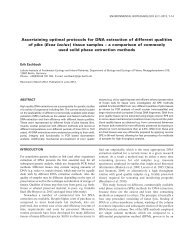26 ENVIRONMENTAL BIOTECHNOLOGY 8 (1) 2012Bothast, R.J., B.C. Saha. 1997. Ethanol <strong>production</strong> <strong>from</strong> agriculturalbiomass substrates. Advances and Applied Microbiology 44: 261-286.Campbell, C.J., J.H. Laherrere. 1998. The end <strong>of</strong> cheap oil. ScientificAmerican 278: 78-83.Clark, J.H., F.E.I. Deswarte. 2008. Introduction to Chemicals <strong>from</strong>Biomass. 184 p. A John Wiley and Sons, Ltd, Publication.Cookson, C. 2007. Bi<strong>of</strong>uel crops to transform UK landscape.Financial Times.Council <strong>of</strong> the European Union. 2007. Brussels European council 8/9march 2007 presidency conclusion. 7224/1/07, REV 1. 25 p.Dale, B.E. 2007. Thinking clearly about bi<strong>of</strong>uels: ending theirrelevant net energy debate and developing better performancemetrics for alternative fuels. Bi<strong>of</strong>uels Bioproducts andBiorefining 1: 14–17.Dien, B.S., M.A. Cotta, T.W. Jeffries. 2003. Bacteria engineered forfuel ethanol <strong>production</strong> current status. Applied Microbiology andBiotechnology 63: 258-266.Doolittle, J.J., L. DoKyoung, P. Jeranyama, V. Owens, A. Boe. 2006.Composition <strong>of</strong> lignocellulosic feedstock for bi<strong>of</strong>uels andbioproducts. ASA-SSSA-SSSA International Meetings,Indianapolis, USA.EREC (European Renewable Energy Council). 2004. RenewableEnergy Policy Review. 15 p.European Commission. 2006. EUR 22397 - The state and prospects<strong>of</strong> European energy research. Comparison <strong>of</strong> commission,member and non-member states R&D portfolios. 121p.European Commission. 2007. AGRI G-2/WM D. Impact Assessment<strong>of</strong> the Renewable Energy Roadmap. Directorate-General forAgriculture and Rural Development. Directorate G. Economicanalysis, perspectives and evaluations. G.2. Economic analysis <strong>of</strong>EU agriculture. 10 p.FAO (Food and Agriculture Organization <strong>of</strong> the United Nations).2008. FAOSTAT. http://faostat.fao.org (24 March 2008).Farrell, A.E., R.J. Plevin, B.T. Turner, A.D. Jones, M. O'Hare, D.M.Kammen. 2006. Ethanol can contribute to energy andenvironmental goals. Science 311: 506-508.Ferreira, V., M. de Oliveira Faber, S. da Silva Mesquita, Jr., N.Pereira. 2010. Simultaneous saccharification and fermentationprocess <strong>of</strong> different cellulosic substrates using a recombinantSaccharomyces cerevisiae harbouring the β-glucosidase gene.Electronic Journal <strong>of</strong> Biotechnology 13: 1-7.Goettemoeller, J., A. Goettemoeller. 2007. Sustainable Ethanol:Bi<strong>of</strong>uels, Biorefineries, Cellulosic Biomass, Flex-FuelVehicles,and Sustainable Farming for Energy Independence. 196 p. PrairieOak Publishing, Maryville, Missouri.Gołaszewski, J., W. Budzyƒski, K. Jankowski. 2008a. Production <strong>of</strong>liquid bi<strong>of</strong>uels – energy efficiency. International Conference“Oils and Fuels for Sustainable Development” – AUZO 2008,Gdaƒsk.Gołaszewski, J. 2009a. Renewable energy sources and environmentalenhancement and protection. III Nationwide ScientificConference in Poland, Environmental Protection andEnhancement. “Natural, Technical and Social-and-EconomicConditionalities”. Olsztyn, Poland.Gołaszewski, J. 2009b. Biorafinerie/technologie bioenergetyczne –stan obecny i perspektywy rozwoju [Biorefineries/bioenergentictechnologies – present state and developmental perspectives].Proceedings <strong>of</strong> International Conference “Renewable EnergyTechnologies and Polygeneration”: 20-33. Poznaƒ, Poland. InPolish.Gołaszewski, J. 2009c. Renewables and environmental implications.Environmental Biotechnology 5: 11-24.Gołaszewski, J., W. Budzyƒski, K. Jankowski. 2008b. Seeds as thesource <strong>of</strong> bi<strong>of</strong>uels. Proceedings <strong>of</strong> the 9th ISSS Conference onSeed Biology, Olsztyn, Poland: 141-148.Gołaszewski, J., W. Bednarski, M.K. Łuczyƒski, M. Stolarski, M.Góra, M. Lewandowska, E. Olba-Zi´ty. 2011. Current researchon lignocellulosic biorefinery in Poland. 3rd Nordic WoodBiorefinery Conference, Proceeedings: 229-231. Stokholm, Sweden.Hahn-Hägerdal, B., M. Galbe, M.F. Gorwa-Grauslund, G. Lidén, G.Zacchi. 2006. Bioethanol – the fuel <strong>of</strong> tomorrow <strong>from</strong> theresidues <strong>of</strong> today. Trends in Biotechnology 24: 549-56.Hamelinck, C.N., A.P.C. Faaij. 2006. Outlook for advanced bi<strong>of</strong>uels.Energy Policy 34: 3268-3283.Hari Krishna, S., G.V. Chowdary. 2000. Optimization <strong>of</strong>simultaneous saccharification and fermentation for the<strong>production</strong> <strong>of</strong> ethanol <strong>from</strong> lignocellulosic biomass. Journal <strong>of</strong>Agricultural and Food Chemistry 48: 1971-1976.Harrow, G. 2008. Ethanol <strong>production</strong>, distribution, and use.Discussions and key issues. National Renewable EnergyLaboratory. http://www.nrel.gov.Hill, J. 2007. Environmental costs and benefits <strong>of</strong> transportationbi<strong>of</strong>uel <strong>production</strong> <strong>from</strong> food- and <strong>lignocellulose</strong>-based energycrops. A review. Agronomy for Sustainable Development 27: 1-12.Himmel, M.E., S.Y. Ding, D.K. Johnson. 2007. Biomassrecalcitrance: engineering plants and enzymes for bi<strong>of</strong>uels<strong>production</strong>. Science 315: 804-807. http://www.sciencemag.org/content/315/5813/804.full - aff-1.IEA (International Energy Agency). 2004. Energy Statistics Manual.Paris, France. 196 p.IEA (International Energy Agency). 2008. Energy TechnologyPerspectives 2008. Scenarios and Strategies to 2050. Paris,France. 12 p.IEA (International Energy Agency). 2009. World Energy Outlook2009. Paris, France. 15 p.Ingram, L.O., P.F. Gomez, X. Lai, M. Moniruzzaman, B.E. Wood,L.P. Yomano, S.W. York. 1998. Metabolic engineering <strong>of</strong> bacteriafor ethanol <strong>production</strong>. Biotechnology and Bioengeenering 58:204–214.Kamm, B., M. Kamm. 2004. Principles <strong>of</strong> biorefineries. AppliedMicrobiology and Biotechnology 4: 137-145.Kamm, B., P.R. Gruber, M. Kamm. 2006. Biorefineries – industrialprocesses and products. Status quo and future directions. 497 p.Wiley-VCH VerlagGmBH& Co. KGaA.Kamm, B., P. Schönicke, M. Kamm. 2009. Biorefining <strong>of</strong> greenbiomass – technical and energetic considerations. Wiley-VCHVerlagGmBH& Co. KGaA, CLEAN 37: 27-30.Kovarik, B., H. Ford, F. Charles. 1998. Kettering and the fuel <strong>of</strong> thefuture. Automotive History Review 32: 7–27.Kumar, A. 2009. Bi<strong>of</strong>uels <strong>production</strong> and future perspective.http://www.science20.com/humboldt_fellow_and_science/blog/bi<strong>of</strong>uels_<strong>production</strong>_and_future_perspective-62249.Laufenberg, G., B. Kunz, M. Nystroem. 2003. Transformation <strong>of</strong>vegetable waste into value added products: (A) the upgradingconcept; (B) practical implementations. Bioresource Technology87: 167–198.Licht, F.O. 2009. World ethanol & bi<strong>of</strong>uel report. U.K. AgraInforma Ltd. http://www.agra-net.com.Lin, Y., S. Tanaka. 2006. Ethanol fermentation <strong>from</strong> biomassresources: current state and prospects. Applied Microbiology andBiotechnology 69: 627–642.Macqueen, D., S. Korhaliller. 2011. Bundles <strong>of</strong> energy: The case forrenewable biomass energy. Natural Resource Issues No. 24. 88 p.IIED, London.Miyamoto, K. 1997. Renewable biological systems for alternativesustainable energy <strong>production</strong>. 128p. FAO Agricultural ServicesBulletin.Nonhebel, S. 2005. Renewable energy and food supply: will there beenough land? Renewable & Sustainable Energy Reviews 9:191–201.Obama, B., J. Biden. 2012. Promoting a healthy environment.http://www.barackobama.com/.Ogier, J.C., D. Ballerini, J.P. Leygue, L. Rigal, J. Pourquie. 1999.Ethanol <strong>production</strong> <strong>from</strong> lignocellulosic biomass. Oil & GasScience and Technology 54: 67–94.
Gołaszewski et al. Bioethanol <strong>from</strong> <strong>lignocellulose</strong> 27Ol<strong>of</strong>sson, K., B. Palmqvist, G. Lidén. 2010. Improvingsimultaneous saccharification and co-fermentation <strong>of</strong>pretreated wheat straw using both enzyme and substratefeeding. Biotechnology for Bi<strong>of</strong>uels 3: 17.Patel, M., M. Crank, V. Dornburg, B. Hermann, L. Roes, B. Husing,L. Overbeek, F. Terragni, E. Recchia. 2006. Medium and longtermopportunities and risks <strong>of</strong> the biotechnological <strong>production</strong><strong>of</strong> bulk chemicals <strong>from</strong> renewable resources – the potential <strong>of</strong>white biotechnology. 452 p. The BREW project. Final Report.Perlack, R.D., L.L. Wright, A.F. Turhollow, R.L. Graham, B.J.Stokes, D.C. Erbach. 2008. Biomass as feedstock for abioenergy and bioproducts industry: the technical feasibility <strong>of</strong>a billion-ton annual supply. 78 p. Oak Ridge NationalLaboratory.Reddy, C.A., T.M. D’Souza. 1998. Application <strong>of</strong> PCR in studying<strong>lignocellulose</strong> degradation by basidiomycetes. In: Application<strong>of</strong> PCR in Mycology (ed. P.D. Bridge, D.K. Arora, C.A. Reddy,R.P. Elander), pp. 205-242. Oxon; New York, NY: CAB International.RFA. 2008. The Gallagher Review <strong>of</strong> the indirect effects <strong>of</strong>bi<strong>of</strong>uels <strong>production</strong>. 91 p. UK: The Renewable Fuels Agency.Rowe, R.L., N.R. Street, G. Taylor. 2009. Identifying potentialenvironmental impacts <strong>of</strong> large-scale deployment <strong>of</strong> dedicatedbioenergy crops in the UK. Renewable and Sustainable EnergyReviews 13: 271-290.Saha, B.C. 2003. Hemicellulose bioconversion. Journal <strong>of</strong>Industrial Microbiology and Biotechnology 30: 279-291.Saha, B. C., J. Woodward. 1997. Fuels and chemicals <strong>from</strong> biomass.365 p. American Chemical Society, Washington, DC.Sanders, J. 2009. Sustainability and climate protection, the role <strong>of</strong> bi<strong>of</strong>uels and biorefineries in Europe. Presentation by J. Sanders,Pr<strong>of</strong>essor, BioMotion congress. Agritechnica Hannover.http://www.biomotion-tour.eu/news/sustainability-and-climateprotection-the-role-<strong>of</strong>-bio-fuels-and-biorefineries-in-europejohan-sanders(13 November 2009).Sannigrahi, P., A.J. Ragauskas, G.A. Tuskan. 2010. Poplar as afeedstock for bi<strong>of</strong>uels: A review <strong>of</strong> compositionalcharacteristics. Bi<strong>of</strong>uels Bioproducts & Biorefining 4: 209–226.Sheehan, J., A. Aden, K. Paustian, K. Killian, J. Brenner, M.Walsh, R. Nelson. 2004. Energy and environmental aspects <strong>of</strong>using corn stover for fuel ethanol. Journal <strong>of</strong> Industrial Ecology7: 117–46.Sjöström, E. 1993. Wood Chemistry. Fundamentals andApplications. Second Edition San Diego. 302 p. Academic Press.Sluiter, J.B., R.O. Ruiz, C.J. Scarlata, A.D. Sluiter, D.W.Templeton. 2010. Compositional analysis <strong>of</strong> lignocellulosicfeedstocks. 1. Review and description <strong>of</strong> methods. Journal <strong>of</strong>Agricultural Food Chemistry 58: 9043–9053.Stolarski, M., J. Gołaszewski, M. Krzy˝aniak, M.K. Łuczyƒski. 2009.Non-forest lignocellulosic biomass as the main feedstock inethanol biorefinery. 2nd Nordic Wood Biorefinery Conference,Proceeedings, 1: 13-18. Helsinki, Finland.Szczukowski, S., J. Tworkowski, A. Klasa, M. Stolarski. 2002.Productivity and chemical composition <strong>of</strong> wood tissues <strong>of</strong> shortrotation willow coppice cultivated on arable land. RostlinnaVyroba 48: 413-417.Thomsen, M.H., D. Bech, P. Kiel. 2004. Manufacturing <strong>of</strong>stabilised brown juice for L-lysine <strong>production</strong> – <strong>from</strong> universitylab scale over pilot scale to industrial <strong>production</strong>. Chemical andBiochemical Engineering Quarterly 18: 37-46.Troszkiewicz, Cz., R. Bogoczek. 1954. Sposób hydrolizy drewna lubinnych materiałów zawierajàcych celuloz´ [Method <strong>of</strong>hydrolysis <strong>of</strong> wood or other materials containing cellulose].Patent No. 37643. In Polish.UNEP. 2008. Global Green New Deal - Environmentally-FocusedInvestment Historic Opportunity for 21st Century Prosperityand Job Generation. 104 p.US Department <strong>of</strong> Energy. 2004. Performance and AccountabilityReport: Fiscal Year 2004. 404 p.oe pac.van Vliet, O.P.R., A.P.C. Faaij, W.C. Turkenburg. 2009. Fischer-Tropsch diesel <strong>production</strong> in a well-to-wheel perspective: Acarbon, energy flow and cost analysis. Energy Conversion andManagement 50: 855-876.Weih, M. 2008. Short rotation forestry (SRF) on agricultural landand its possibilities for sustainable energy supply. NordicCouncil <strong>of</strong> Ministers, Copenhagen. TemaNord, 543: 1-66.Willke, T., K.D. Vorlop. 2004. Industrial bioconversion <strong>of</strong>renewable resources as an alternative to conventionalchemistry. Applied Microbiology and Biotechnology 66:131–142.World Economic Outlook 2007: Globalization and Inequality(EPub). International Monetary Fund, 2007. 274 p.Wright, M., R.C. Brown. 2007. Comparative economics <strong>of</strong>biorefineries based on the biochemical and thermochemicalplatform. Bi<strong>of</strong>uels Bioproduct Biorefining 1: 49-56.Wu, Z., Y.Y. Lee. 1998. Nonisothermal simultaneoussaccharification and fermentation for direct conversion <strong>of</strong>lignocellulosic biomass to ethanol. Applied Biochemistry andBiotechnology 70-72: 479-492.Yu, Z.S., H.X. Zhang. 2004. Ethanol fermentation <strong>of</strong> acidhydrolyzedcellulosic pyrolysate with Saccharomyces cerevisiae.Bioresource Technology 93: 199–204.Zhu, J.Y., X.J. Pan, G.S. Wang, R. Gleisner. 2009. Sulfitepretreatment (SPORL) for robust enzymatic saccharification <strong>of</strong>spruce and red pine. Bioresource Technology 100: 2411–2418.Zhu, J.Y., X.J. Pan. 2010. Woody biomass pretreatment forcellulosic ethanol <strong>production</strong>: Technology and energyconsumption evaluation. Bioresource Technology 101: 4992-5002.


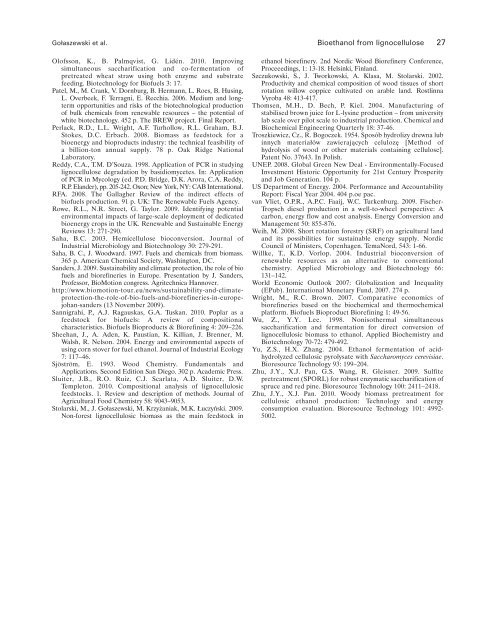
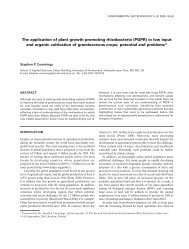
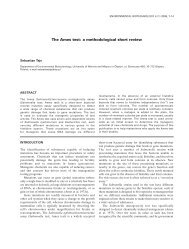
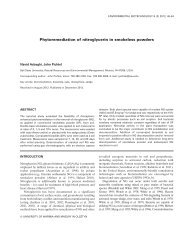

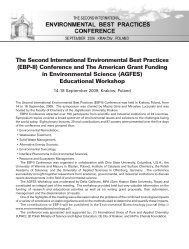
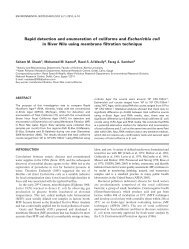
![Genotoxicity of cyclopentha[c]phenanthrene and its two derivatives ...](https://img.yumpu.com/31321772/1/190x249/genotoxicity-of-cyclopenthacphenanthrene-and-its-two-derivatives-.jpg?quality=85)
